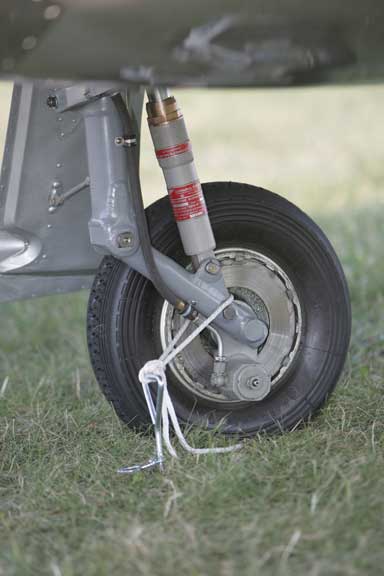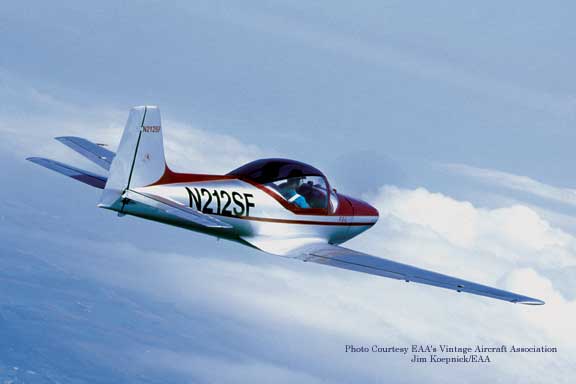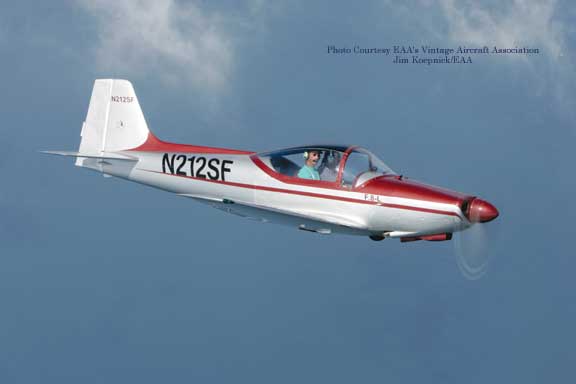Factory Falco
Plywood Butterfly Reborn
![]()
Factory Falco
|
|

While Marc was courting aviation he was also courting and eventually marrying his wife, Gail, and life began to change.
“We had two daughters, Maya and Tobie, and almost immediately we got a rude introduction into parenthood.”
Most people go through life taking an enormous amount for granted and never truly get a handle on who they are or what they place value on. Marc and Gail, however, learned that early.
“Maya was a baby, and they discovered she had a brain tumor and wasn’t likely to live. When someone tells you your daughter won’t live another hour, instantly everything you had placed value on before dwindles to nothing. In a matter of seconds your priorities are totally rearranged. Believe me, if your kids are healthy, you don’t have any problems.
“When you’re waiting around an ICU with parents who have been told their children are likely to die, and you’re one of them, your life gets very simple. You want her to live and nothing else matters.
“Maya lived past that hour. And the next one, and the next. She somehow hung on and survived the surgery that gave her a normal life. She’s 12 years old now and calls herself my ‘pilot girl.’ My other daughter, Tobie, likes horses and spends more time with her mom and the horses, but Maya and I fly a lot. We love taking our little Cessna 120 out camping.”

Having a family and all the associated medical expenses caused Marc to reprioritize life.
“I couldn’t do this loose craftsman thing any more. I had to find a regular job that had medical insurance, so I started working with a CNC operation. I did that for six years and learned a lot that helped me in later years with airplanes.”
His wife, Gail, has always been his strongest supporter, and when she got a solid job teaching school with all the benefits, Marc was instantly back making things with his hands.
“I sought out Bill Scheunemann at Scheunemann Aviation Products in Juneau, Wisconsin (www.woodwings.com). He builds wood wings, specifically wing kits for the One Design and Pitts Model 12. I guess because I knew what a gusset was, he hired me,” Marc laughs. “Also, I knew how to run his three-axis CNC machines, so it was a good combination.
“Even better, I found that Bill not only loved the Falco but actually had a set of plans. We thought, ‘Yeah, why not build one.’” So, he started putting the plans into CAD, and we actually had started making up fuselage jigs when he got a call from Gar Williams.”
Gar Williams needs no introduction in these pages other than to say he’s highly revered as a restorer of some exotic antique airplanes as well having interests in all fields of aviation.
“Gar said to Bill, ‘I hear you have someone up there who would like to have a Falco; if you aren’t too far along building yours, stop right now!’ He was talking about me.”
It turned out that Gar had the damaged airframe of a factory-built Falco, only the second one to be imported into the country in addition to the one Alfred Scott at Sequoia had. Gar was the latest in a long string of owners.
“This airplane is serial number 212, although there were only 75 built,” says Marc, “and the Europeans really don’t like to see them leave the country. They stopped building them in 1960, and they consider them national treasures.
“The original buyer of the airplane was an ex-Luftwaffe pilot who really loved the airplane and flew it 800 hours. I have some of his old tires, however, and he wore them right down to the cords before replacing them, and I think that’s what caused his accident.
“In 1974 he landed and had a flat tire. The airplane has only one brake pedal that actuates both brakes at the same time. So, when he lost the tire, the airplane got sideways. The nose gear folded, which crushed the bottom of the cowling, and one of the mains punched a hole in the wing.”
The airplane was definitely repairable, but apparently the German pilot didn’t want to go that route. “He disassembled the airplane and bought another Falco almost immediately.”
Enter Charlie Yates, who had learned to fly in a Falco in Luxembourg, and after returning to the states, got a call from a friend in Germany about the newly-wrecked Falco. Charlie bought it sight-unseen and had it shipped to him in New Jersey, where it sat in a barn for a decade. When Sequoia started marketing the Falco, Charlie started work on the Falco, but business activities left no time for the airplane, so he sold it. On the way to the next owner, the trucking company ran a forklift through much of the airplane, which did a lot of damage to the fuselage.
“When Gar got the airplane, he did a terrific job of rebuilding all the control surfaces and the gear doors, but he put the project on a shelf and let it sit for a while because of paperwork problems. Then he called me.”
“The truth is I couldn’t even begin to afford this airplane. I could barely afford my little Cessna 120. By this time I was managing a ski slope during the winter and doing stained glass and helping Bill Scheunemann during the summer, and the Falco was worth far more than I could come up with. Besides, I knew Gar had a check from a European for $60,000 just the way it was.”

What Marc didn’t know was that Gar really wanted to see the airplane fly again and wanted to see Marc Stamsta get it.
“It turned out that the other buyer was planning on parting the airplane out in Europe where he would make far more than the $60,000 he paid, and this really bothered Gar. He knew how badly I wanted the airplane, but I told him I’d never be able to afford it. Then he did something I couldn’t believe.
“He knew how important it was for me to fly. I have to fly; it’s as simple as that, and I had the 120 at the time. Gar said, ‘If you sell your airplane you’ll have the down payment, and I’ll set up a payment schedule for the rest. Since I know how badly you want to fly, you’ll have to finish the airplane to keep flying, and that’s my guarantee that you’ll finish it.’ I absolutely couldn’t believe Gar would do that for me, and I was very flattered that someone of his stature put that much stock in me.”
Marc trucked the remains home and began doing an inventory of the damage and missing parts.
“The good news was that there was no rot,” Marc says. “The airplane had been in dry storage all its life, but besides the original accident damage and shipping damage, a lot of stuff was gone or destroyed. Many parts of the airplane, like the dorsal fin and the fairings, are pretty fragile. They are made of laminated 1/32-inch veneer so it can’t survive rough handling, and I had to make entirely new ones.
“Most of the major structure, like the fuselage longerons and wing spars, were in great shape, but the skins in many areas were split or broken. The bottom of the cowl and the nosebowl were badly crunched, and the windshield was broken although the canopy itself was still usable, although it was crazed in the corners.
|
|
Go back to Marc Stamsta